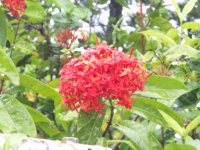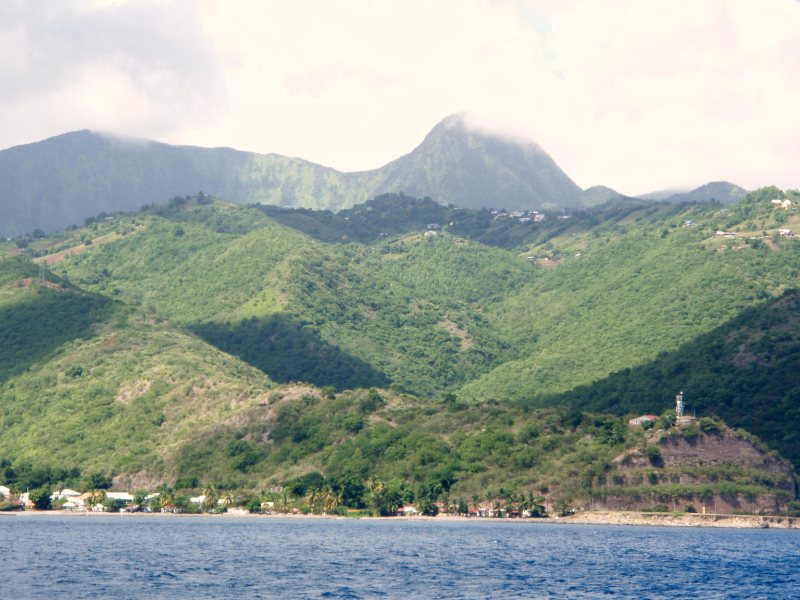The
north of the island is mountainous and lushly forested. It features four
ensembles of dramatic pitons and mornes: the Piton Conil on the extreme North,
which dominates the Dominica Channel, the Mount Pelee, an active volcano, the
Morne Jacob, and the Pitons du Carbet, an ensemble of five beautifully shaped,
rainforest covered extinct volcanoes dominating the Bay of Fort de France at
1,196 metres. The most dominating of the island's many beautiful mountains, at
1397 metres is the infamous volcano Mount Pelee. The volcanic ash has
created unusual grey and black sand beaches in the north (in particular between
Anse Ceron and Anse des Gallets), contrasting markedly from the white sands of
Les Salines in the south.
The south is more easily
traversed, though it still features some impressive geographic features. As it
is easier to travel and because of the many beautiful beaches and food
throughout this region, the south receives the bulk of the tourist traffic. The
beaches from Pointe de Bout, through Diamant (which features right off the coast
the beautiful Roche de Diamant, Diamond Rock), St. Luce, the town of St. Anne
all the way down to Les Salines are very popular.

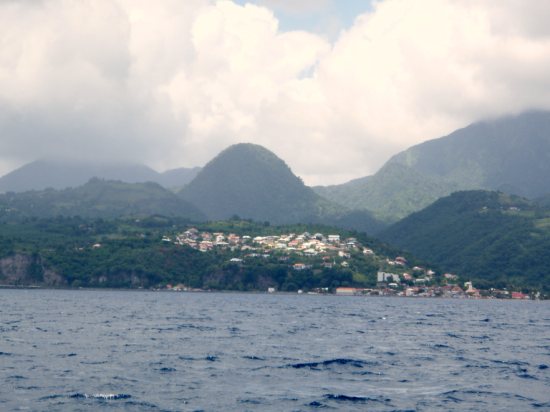
As an overseas department of
France, Martinique's culture blends French and
Caribbean
influences. The city of Saint-Pierre was destroyed by the volcanic eruption of
Mount Pelee on the 8th of May 1902, all 30,000 inhabitants were
perished except for one prison inmate. The town was often referred to as the
Paris of the Lesser Antilles. Following traditional French custom, many businesses close at midday,
then reopen later in the afternoon. The Creole spoken here is
virtually identical to the varieties spoken in neighbouring English-speaking
islands of Saint Lucia and Dominica. Mostly based on French and African
languages, Martinique's creole also incorporates a few elements of English,
Spanish, and Portuguese. Originally passed down through oral storytelling
traditions, it continues to be used more often in speech than in writing. Its
use is predominantly with friends and family. It is normal not to be used
in professional situations, although it is being increasingly used in the media
and by politicians as a way to redeem national identity and by fear from a
complete cultural assimilation by mainland France. The local Creole is, for the
most part, intelligible to speakers of Standard French, as it has lost some of
its distinct dialectal qualities.

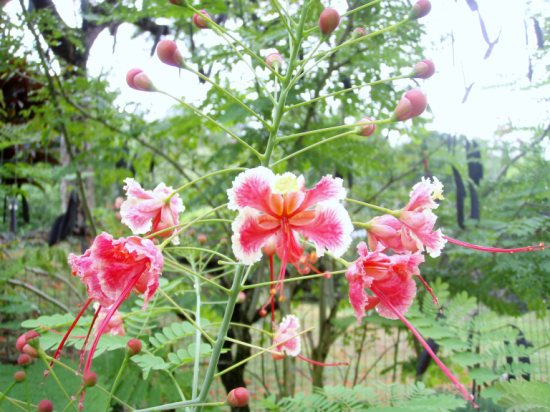
Martinique, locally known
as Madinina - The Isle of Flowers is centrally located at the heart of the arc
formed by the Antilles, Dominica to the north St. Lucia to the south. Like most
of the isles of the West Indies Christopher Columbus landed. He set foot on
Carbet beach during his fourth expedition in 1502. In 1635, Belain d'Esnambuc
started the first colony on the island from that very same beach. Royal Fort,
now Fort de France was founded in 1669. The English interest in this fertile
land resulted in numerous conflicts and changes in rule between 1762 and 1848.
Most of Martinique's
population is descended from African slaves brought to work on sugar plantations
during the colonial era, generally mixed with some French, Amerindian, Indian
(Tamil), Lebanese or Chinese elements. Between 5 to 10% of the population is of
Eastern Indian (Tamil) origin. The island also boasts a small Syro-Lebanese
community, a small but increasing Chinese community, and the "Beke" community,
White descendants from the first French and British settlers, which still
dominate parts of the Agricultural and Trade sectors. The Beke people (whites,
which total around 5,000, most of them of aristocratic origin) generally live in
mansions on the Atlantic coast of the island mostly in the Francois - Cap Est
district. In addition to the island population, the island hosts a metropolitan
French community, most of which lives on the island on a temporary basis
- generally from three to five years.


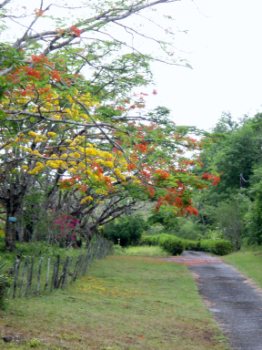
Today, the island enjoys a
higher standard of living than most other Caribbean countries. The finest French
products are easily available, from Chanel fashions to Limoges
porcelain. Studying in the metropole is common for young adults. For the rest of
the French, Martinique has been a vacation hotspot for many years, attracting
both upper-class and more budget-conscious
travelers.
Martinique has a hybrid cuisine,
mixing elements of African, French, and Asian traditions. One of its most famous
dishes is the Colombo, a unique chicken curry, meat or fish with
vegetables, spiced with a distinctive masala of Tamil origins
acidulated with tamarind and often containing wine, coconut milk and rum. There
is also a strong tradition of creole desserts and cakes, often using pineapple,
rum and a wide range of local ingredients. Just like all the other islands we
have been to, Martinique has ten active distilleries and local rums such as:
Depaz, Dillon, JM, La Favorite, La Mauny, Neisson, Saint James and Tris Riviere,
to name but a few are popular. The rum making season is February to June. About
eight kilometres west of Sainte-Luce, the Trois Rivieres estate was originally
part of a 5,000 hectare land grant to Nicholas Fouquet during the reign of Lois
XIV in 1661. While amassing great wealth, Fouquet attracted the jealousy of the
king and after having his assets confiscated he died in prison at the age of
sixty-five in 1680. Today his property is a distillery museum complete with
working windmill, overlooking the Caribbean Sea. When Mount Pelee erupted many
of the ships anchored could not clear and countless numbers caught fire and
sunk. The sixteen distilleries in the town were also destroyed, but today the
sugar cane fields on Mount Pelee are some of the most productive of the
island.
Martinique in
Popular Culture:
Martinique was the main setting
of the 1944 film To Have and Have Not starring Humphrey Bogart
and Lauren Bacall.
The island is mentioned in the
song Uffington Wassail by Half Man Half Biscuit.
In the gothic soap opera Dark
Shadows, the characters of Angelique Bouchard Collins, Josette du
Pres, and Josette's family are from Martinique.
Martinique was also featured in
the 1999 remake of "The Thomas Crown Affair,"
and in the movie "Sugar Cane Alley".
It is also mentioned in the
Beach Boys hit "Kokomo"
with the line "To Martinique, that Montserrat mystique".
Josephine de
Beauharnais, made Empress in 1802, was the wife of Napoleon. She was
born on the Pagerie Estate in Trois Islet, (own blog).
Martinique is France with coconut trees, with lovely, helpful people who
speak very good English. Where we were anchored it felt very much like being in
Guernsey and very homely.
ALL IN ALL LOOKING FORWARD TO RETURNING NEXT
SEASON TO SPEND LONGER EXPLORING THE
ISLAND.
COMFORTABLY EUROPEAN IN
IT'S APPEARANCE, ATTITUDE, STRUCTURE AND SERVICES.






